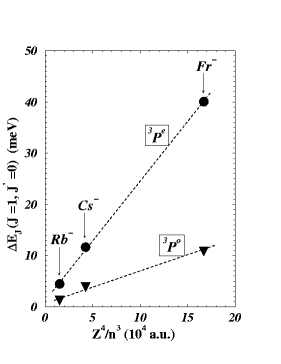
Figure 1:
The splitting
ΔEJ(1,0)
between the J=0 and J=1 terms
of the
3Po (triangles)
and
3Pe (circles) resonances
vs. Z4/n3.
FESHBACH RESONANCES AND VIRTUAL STATES IN ELECTRON
SCATTERING BY Rb, Cs, AND Fr ATOMS AT LOW-ENERGIES
Cristian Bahrim, Uwe Thumm
Department of Physics, Kansas State University, Manhattan, KS 66506-2604, USA
Ilya I. Fabrikant
Department of Physics and Astronomy, University of Nebraska, Lincoln, NE 68588-0111, USA
In the last decades, negative ions have attracted much interest from both theorists and experimentalists and some reviews have been devoted to this subject1. Nevertheless, the spectra of many negative ions, especially the heavy anions, have not been investigated in detail. Based on the Dirac R-matrix method2, we analyze the spectra of Rb-, Cs-, and Fr- anions below the first np excitation thresholds of Rb(5p), Cs(6p), and Fr(7p), in electron scattering calculations.
The model potential we use to describe the electrostatic interaction between the projectile electron and the atomic targets (Rb, Cs, and Fr) is based on an effective two-electrons approach, in which the valence and scattered electron of the electron-alkali atom system move in the field of a polarizable noble-gas-like core2,3. The available data provided by both theory and experiment suggest that the low-lying spectra of different negative alkali-metal ions are similar1. Recently, we have confirmed in elaborate Dirac R-matrix calculations that the lowest 3Po excited state for Rb- and Cs- ions is a shape resonance rather than a bound state, in excellent agreement with electron scattering and photodetachment measurements3. We have predicted that the lowest 3Po state of Fr- is also a resonance, at 32 meV above the detachment threshold3.
Our new relativistic Dirac R-matrix calculations for electron scattering at energies below the Rb(5p), Cs(6p), and Fr(7p) excitation thresholds allow to identify the 3Pe and 1Po1 Feshbach resonances . For Cs and Fr targets, our calculation indicates the presence of a new 1Do2 resonance at a few meV below the lowest np3/2 atomic excitation threshold. We provide the positions, widths, and shape for all these resonances in both partial and total elastic cross sections. The influence of the long-range electrostatic interaction and the short-range electron correlations on the 3Pe, 1Po1 and 1Do2 Feshbach states is investigated. Comparison with available experiments is done4. We find that the splitting ΔE(J,J-1) between adjacent fine-structure components J of same triplet resonance located below the first Rb(5p1/2), Cs(6p1/2), and Fr(7p1/2) thresholds, increases linearly with Z4/n3, as in the case of hydrogenic ions. Here n is the principal quantum number which defines the dominant nl n'l' configurations (n=5(Rb), 6(Cs), and 7(Fr)) for each resonance, and Z is the charge of the nucleus.
Figure 1 shows this linear dependence for the 3Po, shape and 3Pe Feshbach states of Rb-, Cs-, and Fr-.
Based on the relativistic version of the modified effective range theory5, which extrapolates eigenphases provided by the Dirac R-matrix calculations toward energies below 1 meV, we compute highly accurate 3Se and 1Se scattering lengths in e- + Rb(5s), Cs(6s), and Fr(7s) elastic collisions.
Figures:

Figure 1:
The splitting
ΔEJ(1,0)
between the J=0 and J=1 terms
of the
3Po (triangles)
and
3Pe (circles) resonances
vs. Z4/n3.
References:
1) S.J. Buckman and Ch.W. Clark, Rev. Mod. Phys. 66, 539 (1994);
T. Andersen, H.K. Haugen, and H. Hotop, J. Phys. Chem. Ref. Data 28, 1511 (1999).
2) U. Thumm and D.W. Norcross, Phys.Rev.A 45, 6349 (1992).
3) C. Bahrim and U. Thumm, Phys. Rev. A 61, 022722 (2000).
4) C. Bahrim, U. Thumm, and I.I. Fabrikant, Phys. Rev. A, in press
5) C. Bahrim, U. Thumm, and I.I. Fabrikant, J. Phys. B, in press
This work was supported by the
Chemical Sciences, Geosciences and Biosciences Division,
Office of Basic Energy Sciences,
Office of Science,
U.S. Department of Energy.
Submitted to ICPEAC 2001, July 2001 in Santa Fe, NM.
This abstract is also available in Postscript or Adobe Acrobat formats.
|
|